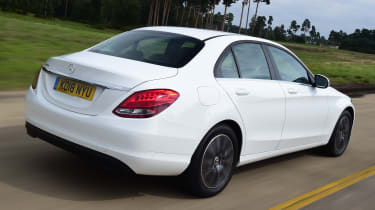Used Mercedes C-Class (Mk4, 2014-2021) - How much will it cost?
The Mk4 Mercedes C-Class is still a premium product and you will pay for the privilege of owning it, but it should hold its value well
The Mercedes C-Class Mk4 will cost a bit more to buy than its non-premium counterparts, although it should be a bit more affordable than its direct rivals due to the car’s lower residual values. Fuel economy is pretty good across the board, but do take note that the Mercedes sits in higher insurance groups than some of its alternatives and can be a bit pricey to service.
Prices
Despite what the prestige of the Mercedes badge on the bonnet may suggest, the C-Class Mk4 doesn’t have the strongest residual values of its peers. Because of that depreciation, the Mercedes should be a lot more affordable to buy now than it was brand new.
If you’re looking for the most cost-effective way into fourth-gen C-Class ownership, you’ll need to consider the less powerful petrol and diesel options, with the latter likely to make up a large chunk of the used listings you’ll find for the Mercedes. Expect to pay a premium for higher-spec cars, with the AMG models being the priciest examples you can buy.
To check out how much your ideal Mercedes C-Class Mk4 will cost, make sure you check out the used listings on our sister site Buyacar.
Fuel economy and emissions
The Mercedes C-Class Mk4 was available with many engine types, and so the fuel economy varies considerably depending on what’s under the bonnet. If you’ll primarily be doing longer drives, the diesels will be the most efficient options. Mercedes claimed the C220d could return up to 55.4mpg, and quoted a slightly worse 51.4mpg figure for the more powerful C300d. Officially, the entry-level C200d was capable of up to 68.9mpg, though that model’s fuel economy wasn’t calculated using the same method as the C220d and C300d.
Other models whose fuel economy figures you shouldn’t take at face value are the plug-in hybrid C300e and C300de versions. These models are claimed to return up to 188mpg and 235mpg respectively, but that is wholly dependent on how often you’re able to drive the car using just the electric motor. However, because both plug-in hybrids have low CO2 emissions of up to 37g/km, they incur the most affordable annual tax rates.
Used - available now

2015 Mercedes
C Class
63,503 milesAutomaticDiesel2.1L
Cash £12,693
2017 Mercedes
C Class
64,643 milesAutomaticPetrol2.0L
Cash £10,995
2019 Mercedes
C Class
41,392 milesAutomaticDiesel2.0L
Cash £17,000
2019 Mercedes
C Class
17,210 milesAutomaticDiesel2.0L
Cash £17,100Perhaps unsurprisingly, the petrol engines are the least frugal ones available on the Mercedes C-Class Mk4, though they’re still efficient considering the fuel they use. The C200 model is capable of returning 42.2mpg, and the C300 is a bit worse at 39.8mpg. Unsurprisingly, the AMG models are the least efficient in the C-Class Mk4 range, with Mercedes quoting 29.1mpg and 26.2mpg for the C43 and C63, respectively.
Running costs
The Mercedes C-Class Mk4 doesn’t have strict service intervals, because all cars come with a system that monitors the condition of key components and alerts the driver using dashboard prompts when maintenance work is needed. As a result, no two servicing jobs will be the same. As a rule of thumb, though, Mercedes recommends a check-up once every 24 months or 20,000 miles, whichever comes first. Services alternate between minor and major, and prices will start from around £370.
All of the C-Class Mk4’s engines are chain-driven, so there aren’t any cambelts to replace. The brake fluid does need to be renewed every two years, though, and this job is carried out as part of the service.
The Mercedes C-Class Mk4 will likely be a bit more expensive to insure than some of its main rivals, because it sits in slightly higher insurance groups. The C-Class ranges from insurance group 23 to insurance group 49 – in comparison, the Audi A4 ranges from insurance groups 19 to 44, and the BMW 3 Series’ insurance groups range from 18 to 45.








